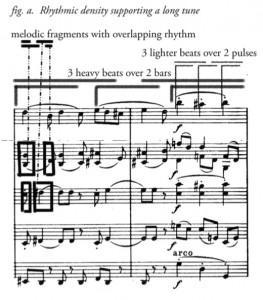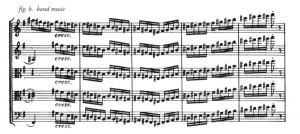 It isn’t clear exactly why JOHANNES BRAHMS set out to write a second string quintet in 1890, other than it was his job to be a composer. It seems possible that in writing the quintet, Op. 111, Brahms was depressedly reworking material meant for symphonies which weren’t coming satisfactorily to fruition, and it is said that he intended this quintet to be his last composition. But his work on
It isn’t clear exactly why JOHANNES BRAHMS set out to write a second string quintet in 1890, other than it was his job to be a composer. It seems possible that in writing the quintet, Op. 111, Brahms was depressedly reworking material meant for symphonies which weren’t coming satisfactorily to fruition, and it is said that he intended this quintet to be his last composition. But his work on
the quintet brought from him a very generous – even optimistic – compositional spirit. Unlike his clarinet quintet, it doesn’t have any qualities of lastness, lateness, or falling leaves; and of course, this quintet didn’t turn out to be his last composition after all. Upon reading through the piece, his old friend Joachim wrote, ‘I am enormously struck by its boldness [and] strength.’ Another friend, Elizabeth von Herzogenberg (who gave some very astute and direct musical commentary to Brahms over the years), wrote, ‘He who can invent all this must be in a happy frame of mind!’
It should not be difficult for a listener to believe that some of the material for the quintet, particularly in its opening, arose from sketches for symphonies. A sense of vastness and ebullience comes immediately from the cello launching itself toward a shining surface made from four tight-knit upper voices. And when that surface is broken, strong, light nettings of rhythmic structure (see fig. a above) preserve the singleness and buoyancy of the tune for a full 38 bars. And so it lives – largely. But the quintet is no symphony, and it does not take a symphonic course. By the end of the last  movement, it has transformed from Viennese abstract to pure gypsy string-band, navigating wild unisons (see bars 242-246, fig. b) which could come straight from the Prater of Brahms’ Vienna.
movement, it has transformed from Viennese abstract to pure gypsy string-band, navigating wild unisons (see bars 242-246, fig. b) which could come straight from the Prater of Brahms’ Vienna.
Given the amount of music between the occurrence of the music at figs. a and b, little is spoiled in revealing the end. The ride is the ride is the ride, and everyone may find moments in it which move them more or less, or which merit special mention. Such was the experience of Ms. von Herzogenberg (the astute critic, cited above): ‘I will not weary you by describing the beauties of the work bar by bar. You know them better than I do.’ But then again, even she was forced, happily, to digress just a bit: ‘I must mention the Adagio…’